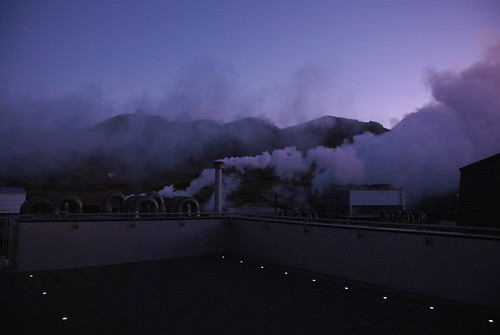
Hellisheiði Geothermal Power Plant, at Hengill.
The landscape of southern Iceland is a vast treeless environment; a desert of lava flow, salt flats, and luxuriant mosses. It is so perfectly horizontal you would swear you could see the curvature of the planet. At certain points steam rises directly from the earth, whipped up by the wind into sulphurous slipstreams, backlit by the five hour sunrise that is hibernal day. The ground is warm to the touch at these places, and is marked by the brown stain of burned vegetation. Sometimes there is a puncture, a pool of bubbling water, sometimes just darkened soil.

This is the primary power source of the Icelanders, geothermal energy. At Hengill, in the south, bores have been sunk to a depth of 3000m, where the water is several hundred degrees in temperature. Through a complicated system of heat exchanges and turbines the plant produces an enormous amount of hot water and electricity, primarily to fuel the ever-hungry aluminium industry. Although Iceland has none of this metal itself, cargo ships will bring ore from as far away as Australia in order to benefit from the cheap electricity.
The over-abundance of power and hot water manifests itself in unusual ways. Graveyards are often lit up 24 hours a day. As you drive through the countryside, rolling through the twilight fog, suddenly a cluster of neon crosses will flash by… Also, everything is heated, the side-walks, the soccer fields. There can be two foot of snow all around a perfectly dry concrete walkway.

“We have so much energy,” a geothermal operator at Sudeyreri’s miniature power plant told me, “that at night we have to disconnect the generators. I’ve been thinking of solutions, and I think that if we could charge electric cars or boats at night we would not be letting so much go down the hill.” He gestured to the steaming rivulet cascading away from the plant.
Its hard to imagine, but if cities like London want to continue into the twenty-first century, they will have to put themselves in the same position…

Indeed, the demand for energy is one of the biggest problems facing both the developed and developing alike.
ReplyDelete